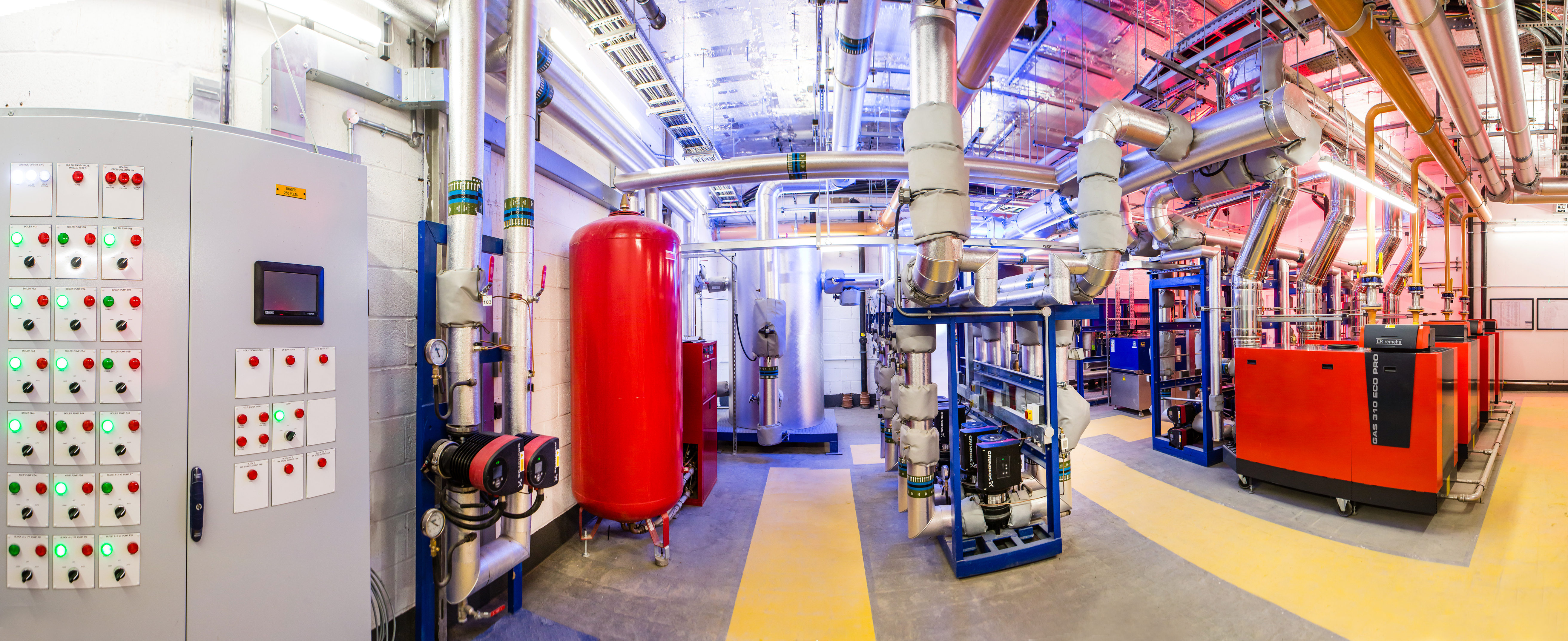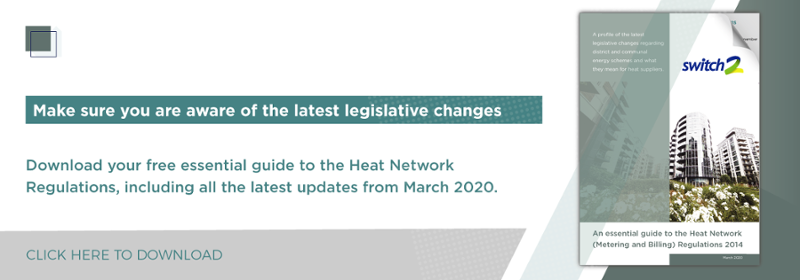31st December 2019 was the deadline for heat suppliers to submit their renotifications of heat networks they operate to the Office for Product Safety and Standards (OPSS). However, we have been made aware only a small portion of the 17,000 heat networks registered in 2015 have been re-registered by the 31st December deadline.
We believe there has been some confusion with the ongoing consultation on the Heat Network Regulations that the requirement to notify (and install point of entry meters) has been suspended. This is not the case. To clarify, the only part of the Regulations suspended is the duty to install end point meters which is subject to the consultation and launch of the new feasibility tool.
Here’s a reminder of the Heat Network Regulations and your obligations as the heat supplier.
The UK Government introduced The Heat Network (Metering and Billing) Regulations in 2014, which covers every community and district heating system across the country. With relatively few exemptions and criminal/civil penalties for non-compliance enforced robustly; it is crucial that those responsible for heat networks understand the obligations and potential benefits.
Legislation at a glance
The UK regulations relate to the distribution of thermal energy from a central source to more than one end user, building or location for the purposes of heating, cooling or hot water supply. The 'heat supplier', which is the person or body ultimately responsible for supplying and charging the 'final customer' (who consumes the heat).
It is obligated to meet three key requirements:
1. Notification
Heat suppliers must inform the Office for Product Safety and Standards (OPSS) about the location of any district heat network or communal heating scheme - as well as its capacity and supply figures. Each building forming part of the network has to be identified, along with the number of customers using it and how they receive information from billing partners. Registrations must be updated every four years of the initial registration, the original deadline for notifying was December 2015, which means that it is now time to re-notify... but we will come back to this point shortly.
Heat suppliers ( of heat, cooling, and/or hot water) must notify OPSS using the notification template, available on the Government website. This has been updated to make notifying them easier and quicker.
2. Metering
Metering has three sections covering final customer metering, point of entry meter for buildings and operation of meters.
It is mandatory to install point of entry, or ‘bulk’ meters (which record the amount of heat delivered into the property) for buildings with one or more customers connected to a district heat network.
Bulk meters need to be installed where there is more than one building supplied by a plant room or energy centre. The definition of a building can be a bit confusing, for example more than one building may share the same envelope (same outer building, separate main entrances, can’t pass between the buildings at any floor levels and have separate heat networks). For more details, please contact us or the OPSS.
There are also rules about what type of building is in and out of scope of the heat network regulations, for example hotels and prisons are out of scope.
A building must have more than one final customer
It is also mandatory to install final customer meters on new builds and most buildings undergoing major renovation. If these meters are not feasible, the viability of heat cost allocators must be considered. The meters require scheduled servicing alongside periodic recalibration of heat cost allocators.
The latest major change to the implementation of the legislation was to postpone the original December 2016 deadline to fit final customer meters to existing unmetered properties. This is due to the withdrawal of the original version of the feasibility tool, that is intended to indicate the financial and technical feasibility of retrofitting meters to existing district and community heating schemes. The original feasibility tool was considered not fit for purpose and is expected to be revised in autumn 2019 following consultation, with the deadline for retrofitting final customer meters being extended thereafter.
If the feasibility tool is used by a heat supplier to opt-out of installing meters, the 'grace period' is only or 4 years, when they Feasibility must be re assessed using up to date costs.. That's because the regulations demand that the feasibility test should be repeated every four years and it is expected that all heat networks will need to be fully metered over time. The law also requires that meters are kept operational and maintained.
|
Heat cost allocators In addition to heat meters, the regulation recognises heat cost allocators as an alternative to heat meters. Heat cost allocators are not commonly deployed in the UK but are very common in Scandinavia and continental Europe. They are used in the instance where pipe work is not suitable. If you what to know more, contact us by clicking here.
|
3. Billing
End customers must be billed using actual meter readings (rather than estimates) at least once a year. However, customers using electronic billing should be invoiced quarterly. Bills must contain current energy prices, details of total consumption (compared to the previous year, if applicable) and general information on how to improve energy efficiency. This is subject to feasibility, however, the bar has been set reasonably high so the rulings will apply in all but a few cases.
The legislation imposes duties on the heat supplier, but BEIS has issued guidance on how these responsibilities may be shared between billing managers and network managers or owners. Internal discussions will be required to establish who is best placed to undertake the billing duties imposed by the legislation.
The impact of Brexit?
Although the regulations stemmed from the EU Energy Efficiency directive, the UK remains committed to carbon reduction and energy efficiency and the role of heat networks in achieving that aim, irrespective of Brexit. As a signatory to the Paris Agreement on climate action and due to the UK's commitment to global energy reduction, it is unlikely that the Heat Network Regulations would be withdrawn.
It should also be noted that if the UK is subject to a Brexit deal, it likely that there will be little change to the requirements.
Benefits of smart metering
The heat network regulations are a transposition of the European Energy Efficiency directive and the reason that heat meters (and controls) are mandated is that it is widely recognised that if people pay a flat rate charge as opposed to paying for metered consumption they use more! In the case of UK social housing this can be up to 50% more! So charging by metered consumption is key to controlling cost, fuel consumption and arguably most importantly CO2 emissions.
Consider smart metering
Smart metering strategies are crucial to reducing energy waste since heat customers can see exactly how much energy they are consuming and paying for and, hence, are able to make informed decisions about reducing their consumption. In our experience, where we have installed smart metering and pay-as-you-go billing, heat usage has been reduced by up to 50%, compared to unmetered dwellings.
Switch2's smart metering partnership with Sheffield City Council is dramatically reducing energy consumption across 6,000 homes connected to its heat network. This is predicted to reduce customers' total annual bill by £1.4 million.
The regulations for metering also offer benefits for heat suppliers. Closer monitoring of district heat networks will provide more opportunities to identify heat loss throughout the network, which could improve operating efficiency. More detailed bills will reduce the volume of customer enquiries about costs and charges, and establish greater trust between suppliers and end users.
Have you submitted your notifications?
If not, Switch2 can help you with this. We are keen to support heat suppliers with their obligations and ensure they are compliant with the regulations.
What can Switch2 do to help me?
- Support the notification process or completely manage this for you
- Provide site surveys to supply the information required to re-notify (e.g. address of the heat network, capacity, generation, number of buildings and final customers)
- Are you compliant for point of entry meters? If not, speak to us.
Contact us today to get started on your notifications and ensure you are compliant.
Key takeaways
- Charging by meter consumption saves your residents money, reduces fuel poverty and reduces CO2 emissions
- There is a tool to confirm if it is not practical to fit heat meters for technical or financial reasons
- If you are not sure if your scheme is in scope of the regulations or you have any questions we would be happy to help
Switch2 can offer support with the renotification process, please contact marketing@switch2.co.uk



